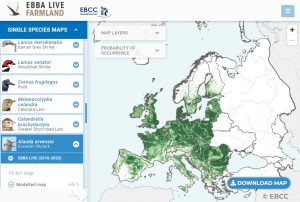EBBA Live Farmland: updating distributions of farmland birds in Europe
May 15, 2024
The publication of the European Breeding Bird Atlas 2 (EBBA2) represented a milestone for European ornithology. Developing a European atlas takes time, and 30 years elapsed between EBBA1 and EBBA2. Updating data on species’ distributions on a more frequent basis and ensuring that they are harmonised across Europe could complement the role of atlases. The European Bird Census Council (EBCC) has started the project EBBA Live, which attempts to fill in this gap of information for as many species as possible. This ambitious project has started with a pilot project on farmland birds, which is called EBBA Live Farmland.
Background
The publication of the European Breeding Bird Atlas 2 (EBBA2) represented a milestone for European ornithology. Developing a European atlas takes time, and 30 years elapsed between EBBA1 and EBBA2. Updating data on species’ distributions more frequently and ensuring that they are harmonised across Europe could complement the role of atlases. The European Bird Census Council (EBCC) has started the EBBA Live project, which attempts to fill in this information gap for as many species as possible. This ambitious project started with a pilot project on farmland birds called EBBA Live Farmland.

Screenshot from the EBBA Live Farmland section of the EBBA2 website
Outputs
The project’s first phase has ended, and the results are available on a specific section of the EBBA2 webpage. The outputs are maps showing the occurrence of 50 farmland bird species based on data from general bird monitoring projects, most of them integrated into the Pan-European Common Bird Monitoring Scheme (PECBMS). New 10-km modelled distribution maps for the post-EBBA2 period 2018–2022 are now available online through the EBBA2 webpage. The work for this phase was carried out in the context of the EuropaBON project.
The results of this first phase show that the existing network of bird monitoring schemes could be used to regularly update the breeding distributions of farmland birds at 10 km resolution by means of spatial distribution modelling techniques.
Modelled maps and underlying data are available for national coordinators for their potential use in research, conservation, or policy-related documents such as Article 12 reporting in EU countries.
Outlook
The second phase of the project has just started. It will also integrate data from EuroBirdPortal (EBP) in the context of the LIFE EBP Reinforcement project. New advancements in modelling techniques are also expected, and changes in distributions will certainly be a hot topic. Detailed results on methods will be published in scientific papers, and modelling codes will be made available.
An invaluable network
The first phase of the project has been possible thanks to the contribution of 50 ornithological organisations from 35 European countries. These organisations coordinate bird monitoring projects based on the fieldwork carried out by thousands of highly skilled birdwatchers without whom EBBA Live Farmland would not have been possible.
Sergi Herrando
May 2024
Contact: ornitologia@ornitologia.org